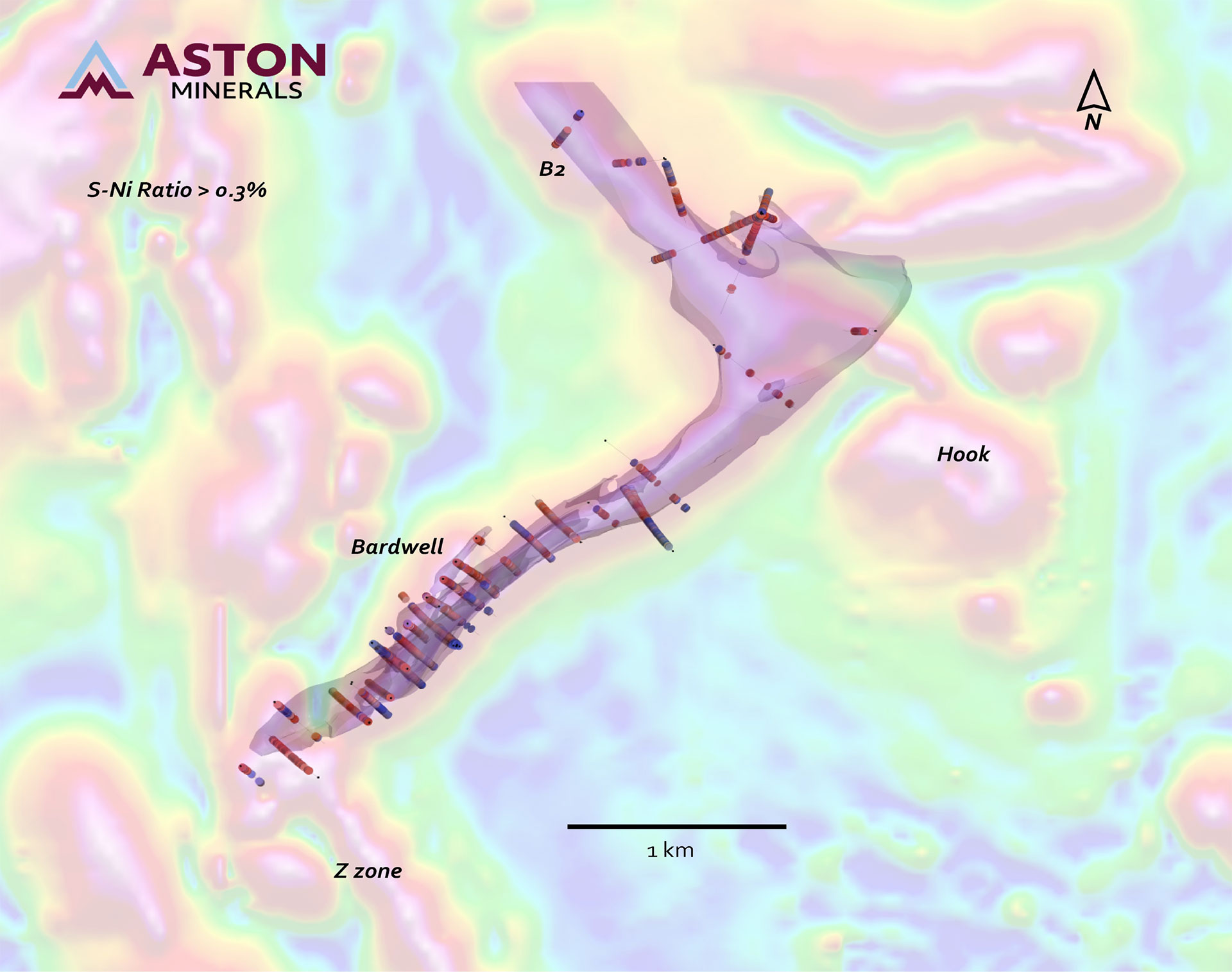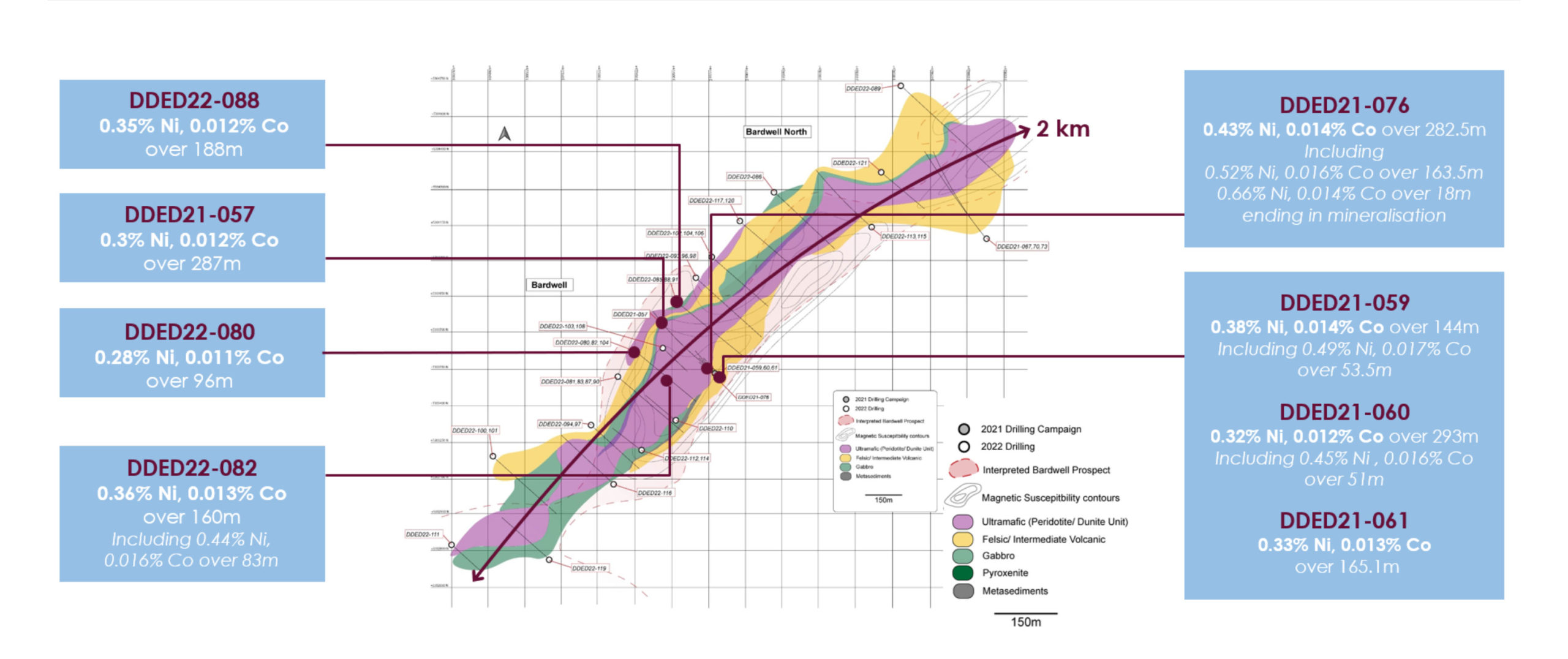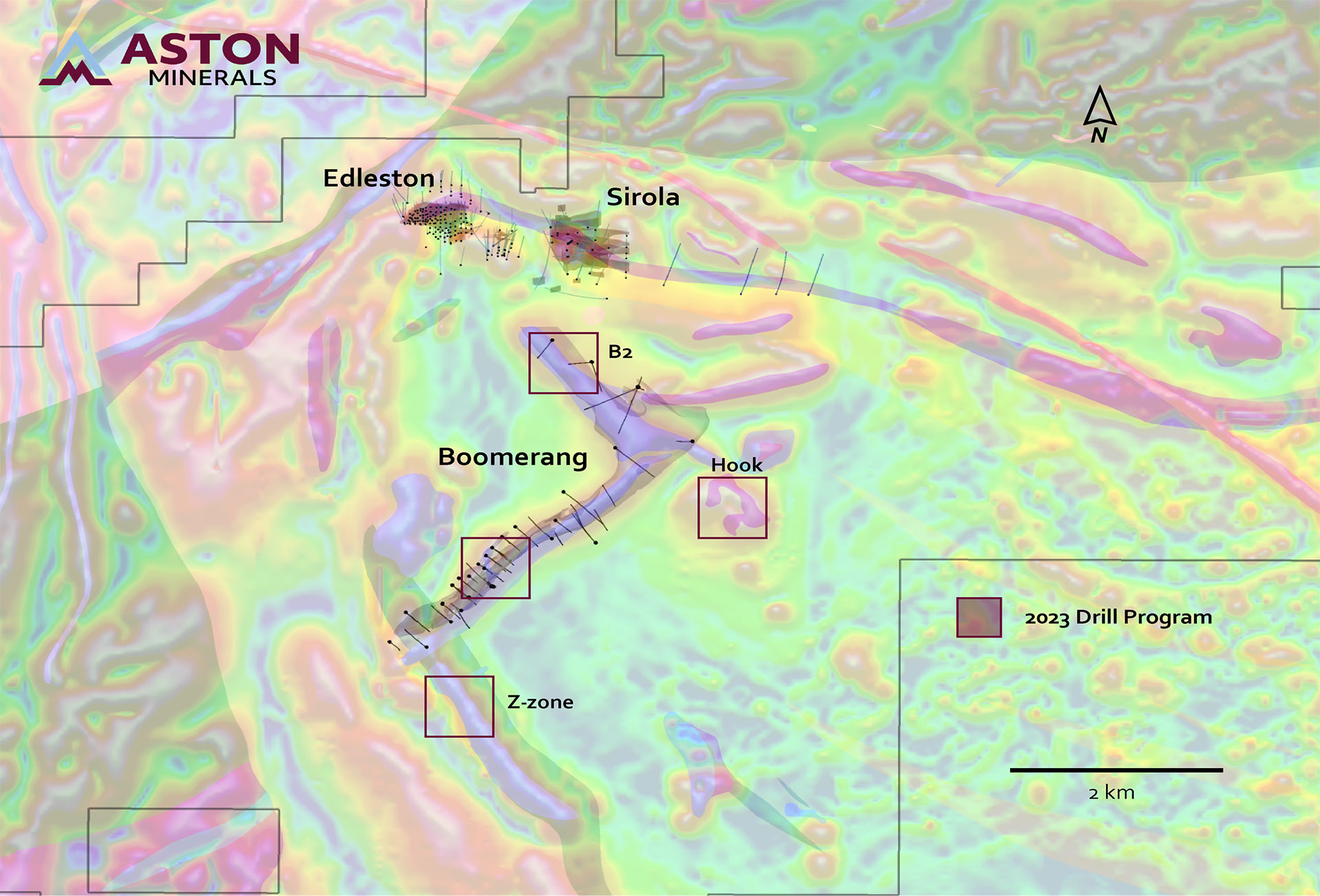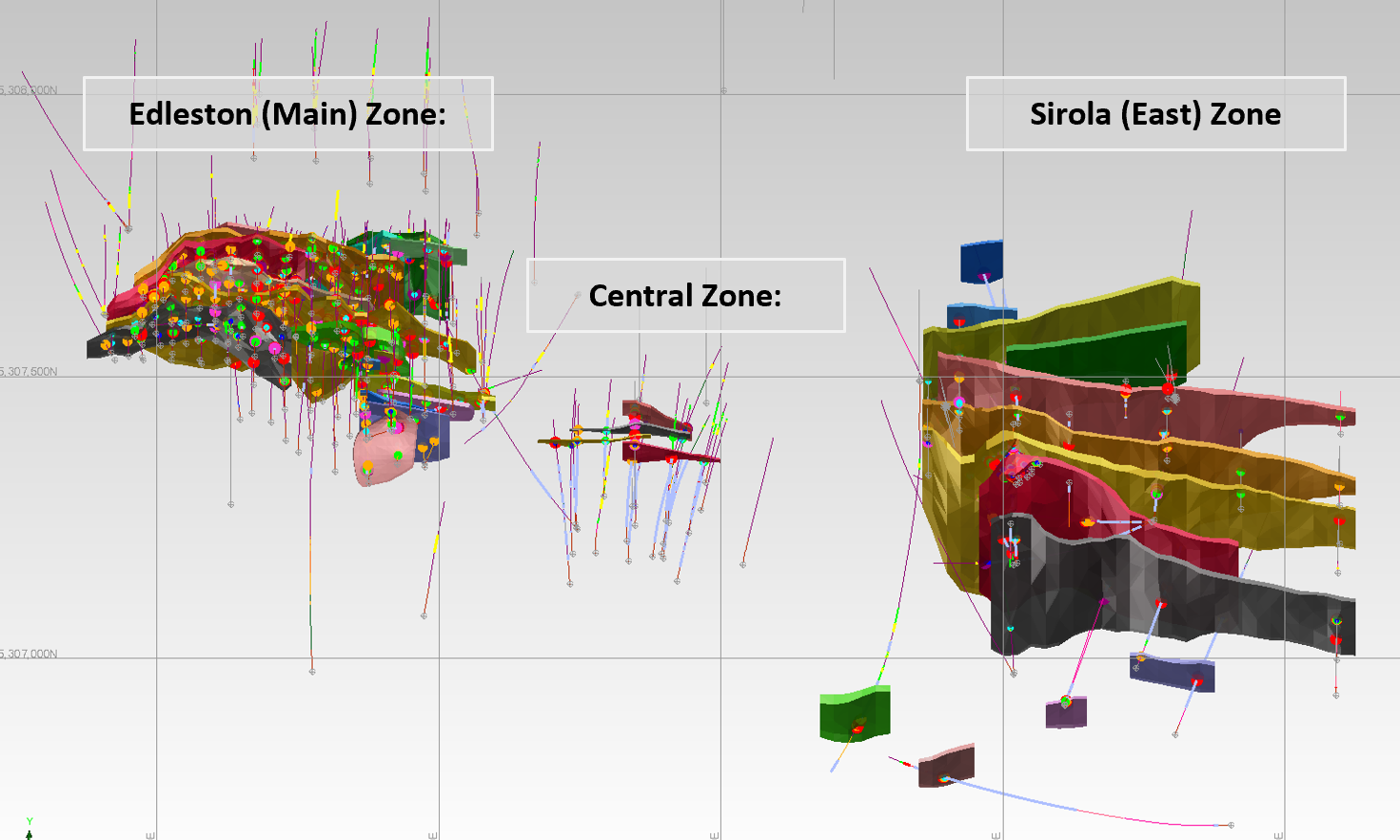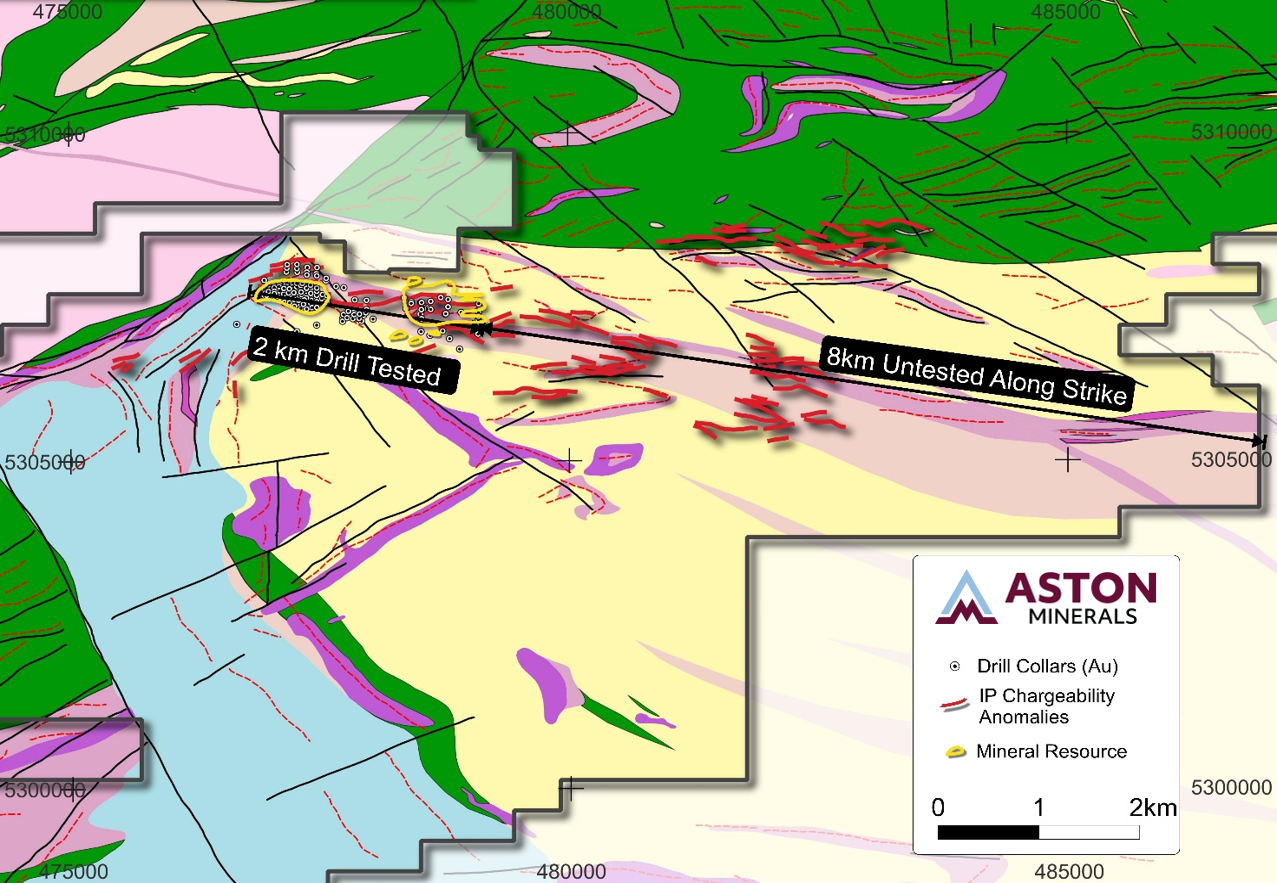Edleston Project
Location
The Edleston Project is located approximately 60km via road to the south of Timmins, Ontario, Canada. The cities of Timmins and Kirkland Lake are located close by and host significant former and current producers, with required services and skilled labour available to support exploration and development of the Project.
Nickel
The Boomerang Resource is situated within a Dunite/Peridotite unit over >6.5 km of strike which has undergone extensive serpentinization. This process of is responsible for the reaction of olivine to produce magnetite and brucite, resulting in a strongly reducing environment whereby nickel is released from decomposition of olivine. The nickel which has been released is typically partitioned into low sulphur nickel sulphide minerals. Due to the magnetite association with mineralisation, a 3D inversion model of magnetics has been generated and has been utilised to assist with targeting.
Key highlights:
- Very wide nickel intersections were initially found while exploring for gold.
- 28,000m of drilling has been done to define the nickel
- Maiden Mineral Resource of 1.044 Billion Tonnes at 0.27%Ni, 0.011% Co announced in February 2023
- Multiple lookalike structures identified
Gold
The Young-Davidson Mine is located to the east and Cote Lake Deposit to the West. The Cadillac – Larder Lake Fault zone where the Project is located within has produced ~75Moz of gold. Within the broader Abitibi Greenstone Belt, a total of 180Moz of gold has been produced since gold was first discovered in the belt in the early 1900’s.
Key highlights:
- 1.5Moz resource announced in January 2023
- From just 2km of a prospective 10km of strike
- Multiple IP chargeability anomalies identified across 8km of strike
- Drilling program underway
Geology and Mineralisation
Edleston is located within the Abitibi Greenstone Belt of Archean metavolcanic and metasedimentary assemblages which have been steeply folded with the axes trending in a general east-west direction. These have been intruded mainly by large granitic bodies and by masses of mafic and ultramafic rocks and well as several ages of younger dolerite dykes. The Abitibi Greenstone Belt extends from north-eastern Ontario and northern Quebec for over 800km.
Regionally the Project is located within the western extension of the Cadillac-Larder Fault Zone along which a number of major gold deposits and mines are located. The occurrence of a Timiskaming conglomerate, similar to that occurring at Kirkland Lake, at several places within the eastern extent of the Project supports this view.
The host lithology is an altered and sheared ultramafic that exhibits extensive silicification and contains abundant quartz-carbonate veins, veinlets and fracture fill. This host unit extends over 10km to the east of the drilled area.
Mineralisation is broadly distributed throughout this lithology as pyrite in ranges of 3 to 5% with trace chalcopyrite and occasional visible gold. Intercalated volcanic and metasedimentary units lie to the north and south of the Edleston mineralised zone.
Nickel – Boomerang nickel sulphide target
Inversion model of magnetics identified a vast nickel target
Within Edleston, the Boomerang Target, a dunite/peridotite unit has undergone extensive serpentinisation. This process converts olivine to magnetite and brucite, releasing the nickel which is typically partitioned into low sulphur nickel sulphide minerals. Initial analysis shows that 93% liberation of nickel is possible with conventional processing methods.
Due to the magnetite association with mineralisation, a 3D inversion model of magnetics has been generated and has been utilised to assist with targeting. This model indicates that Boomerang is a vast target, extending for a strike of ~6,5000 metres, a width of 500 to >1,500 metres, and a depth of well over 500 metres.
Project Highlights
- Drill tested, 28,000m in 13 sections with significant results: Hole 76 hit 164m of 0.52% Ni, Hole 59 hit 53.5m of 0.49% Ni
- Maiden Mineral Resource of 1.044 Billion Tonnes at 0.27%Ni, 0.011% Co announced in February 2023
- Maiden mineral resource covers 4.4kmm of the 6.5km strike length. Multiple lookalike features identified which are yet to be drill tested
- Resource is a dunite/peridotite unit which has undergone extensive serpentisation. The process is responsible for the reaction of olivine to produce magnetite and brucite, resulting in a strongly reducing environment, whereby nickel is released from the decomposition of olivine
- Initial metallurgical testing has produced a saleable nickel-cobalt concentrate with excellent recoveries
Boomerang Prospect – Plan View
Gold – Edleston Main and Sirola Prospects
Along strike 1.5km to the east of the drill defined Edleston Zone is the Sirola Zone which exhibits identical geology and mineralisation and contains some of the only exposed outcrops in the region. Outcrops consist of an altered reddish feldspar porphyry which lies in contact with mineralised ultramafic volcanic. These formations have a general strike of 100 degrees azimuth with a steep dip and are generally sheared and highly altered by carbonatization and silicification.
Maiden Gold Mineral Resource 1.5Moz Au
- Extensive drilling campaign completed between February 2021 to December 2022
- 5.3m at 57.4 g/t Au from 207.4m
Including: 0.35m at 540.3 g/t Au from 208.3m - Indicated Mineral Resource of 14.0 Mt at 0.90g/t Au for 400,200oz Au
- Total Global Resource of 48.1 Mt at 1.00 g/t Au for 1,500,100 oz Au
- 5.3m at 57.4 g/t Au from 207.4m
- Mineralisation originally discovered via testing blind IP chargeability anomalies due to the presence of glacial till obscuring underlying geology
- Multiple paralleling chargeability anomalies defined along strike to the east
- Numerous Sirola lookalike targets along prospective stratigraphy- Sirola accounts for 906.000oz of the 1.5Moz Au resource
- Infill IP surveys being devised to infill survey gaps within the 8km zone of untested stratigraphy
- Broad ~250m drill sections being planned and budgeted across the 8km of strike to east
- 2023 exploration program aims to determine mineralisation potential of the entire system
- 2km of a total of 10km of prospective stratigraphy tested to date




